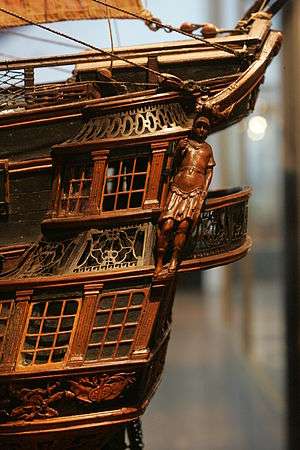French ship Artésien
Artésien (“Artesian”) was a 64-gun ship of the line of the French Navy, lead ship of her class. She was funded by a don des vaisseaux donation from the Estates of Artois.
 Model on display at the Musée de la Marine | |
| History | |
|---|---|
| Namesake: | Artois |
| Builder: | Joseph Ollivier |
| Laid down: | Brest, 1764 |
| Launched: | 1765 |
| Out of service: | 1785 |
| Fate: | Engineering hulk |
| General characteristics | |
| Class and type: | Artésien-class ship of the line |
| Displacement: | 1260 tonnes |
| Length: | 47 m (154 ft) |
| Beam: | 12 m (39 ft) |
| Draught: | 6 m (20 ft) |
| Armament: |
|
| Armour: | timber |
Career
Artésien was built in 1765 as a part of a series of twelve ships of the line began by Choiseul to compensate for the losses endured by the French Royal Navy during the Seven Years' War.[1] She was paid by the province of Artois and Flander, and named in its honour, according to the practice of the time.[2]
During the American revolutionary war, Artésien took part in the Battle of St. Lucia on 15 December 1778,[3] in the Battle of Martinique on 17 April 1780,[4] on the in the Siege of Savannah, under Captain Thomassin de Peynier. [3]
In 1781, Artésien was attached to a division under Suffren, departing France for the Dutch Cape Colony and Isle de France (Mauritius). Off Cape Verde, Artésien detected an English squadron, resulting in the Battle of Porto Praya.[5] Her captain, Cardaillac, was killed by a bullet to the chest at the beginning of the action, and was replaced by First officer de la Boixière.
At the Battle of Sadras on 17 February 1782, she was commanded by Captain Bidé de Maurville.[6] [7] On 7 July 1782, following the Battle of Negapatam, Suffren replaced Maureville with Armand de Saint-Félix.[8] Artésien went on to take part in the Battle of Trincomalee from 25 August to 3 September 1782.[9]
Fate
Artésien was decommissioned in 1785 and used as a shear hulk.
Legacy
A finely-crafted 1/28th scale model was used to instruct Louis XVI in naval studies.[10] The model is now on display at the Musée de la Marine.
Sources and references
Notes
References
- (in French) Archéologie et modélisme d'arsenal
- (in French) Mon carnet de Bretagne
- Contenson (1934), p. 243.
- Troude (1867), p. 71.
- (in French) Liste des régiments et vaisseaux. Archived 2007-10-29 at the Wayback Machine Théatre d'opérations : Etats-Unis 1777-1782
- Meschinet de Richemond (1906), p. 109.
- Cunat (1852), p. 111.
- Cunat (1852), p. 180.
- Levot (1866), p. 468—469.
- Lacour-Gayet (1910), p. 674.
Bibliography
- Boudriot, Jean; Berti, Hubert. Les vaisseaux de 50 & 64 canons 1650 - 1780 (in French). Paris: éditions Ancre. Archived from the original on 2007-10-28.
- Boudriot, Jean (1981). "L'Artésien, vaisseau de 64 canons 1762-1785". Neptunia (in French). Vol. 36. Paris. p. 143.
- Cunat, Charles (1852). Histoire du Bailli de Suffren. Rennes: A. Marteville et Lefas. p. 447.
- Lacour-Gayet, G. (1910). La marine militaire de la France sous le règne de Louis XV. Paris: Honoré Champion.
- Meschinet de Richemond, Louis Marie (1906). Les Marins Rochelais, notes biographiques (in French). La Rochelle: A. FOUCHER.
- Levot, Prosper (1866). Les gloires maritimes de la France: notices biographiques sur les plus célèbres marins (in French). Bertrand.
- Roche, Jean-Michel (2005). Dictionnaire des bâtiments de la flotte de guerre française de Colbert à nos jours, 1671 - 1870. Group Retozel-Maury Millau. pp. 325–6. ISBN 978-2-9525917-0-6. OCLC 165892922.
External links